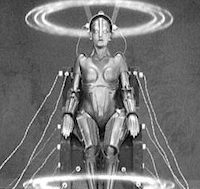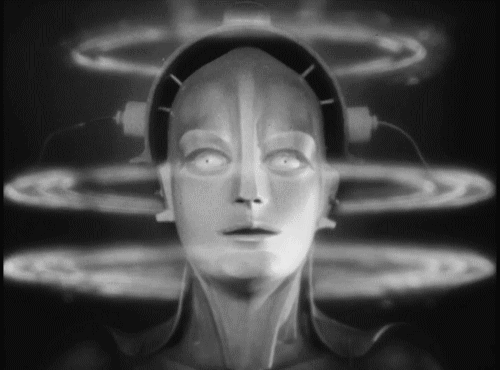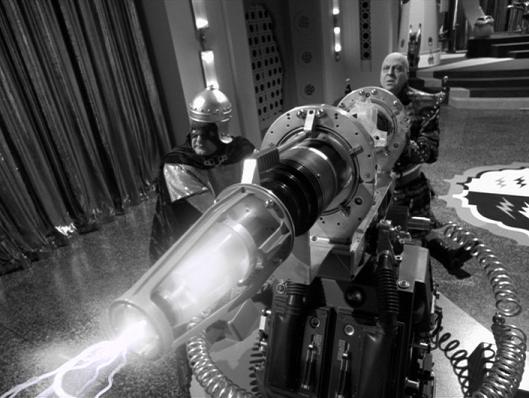
This might seem hard to believe, but there was once a time when television was in the same realm of science fiction as that of cyborgs, interdimensional travel, and designer genetics, a fantastic and impossible contraption that would inspire the imagination of periodical readers everywhere, more often than not represented as a giant window that took up a room and was run on power crystals or some other kind of alien technology. The very idea that someone could watch something going on somewhere else from a room somewhere, that image and sound could be transmitted from one place to another for whoever was there to see it was, at one time, considered an impossible pipe-dream. That you’re reading this paragraph on your PC, laptop, web-enabled smartphone or e-reader, possibly while hurtling through a city in a motor carriage and listening to Skrillex on huge and/or tiny speakers that hang over your ears, shows just how possible these dreams can be, and just how far we’ve come.
It’s uncanny just how much of the technology we use today first showed up in science fiction, from lasers to escalators, from prop planes to space shuttles, and how ideas that spark the minds of sci-fi writers, filmmakers and artists can very often be the very same ones that make scientists and engineers able to build some of the multitude of gadgets and appliances that surround us in everyday life.
So it seems like as good a reason as any to have a look at some famous retro sci-fi tech and see how it compares with some of its modern counterparts and corollaries that we carry around with us and live with every day, to celebrate some of these fantastic wheezes-come-true.
Quantum Leap
For those not familiar with the show, Quantum Leap was a sci-fi series that kicked off in the late 80s following the adventures of Dr. Sam Beckett (Scott Bakula) who, after a failed time travel experiment must “leap” into the bodies of people in different time periods in order to “put right what once went wrong,” aided by his holographic confidante Al (Dean Stockwell.)
While the time travel element and the leaping technology are not likely to ever be realised in our lifetime, one of the show’s gadgets in particular bears a startling resemblance to a piece of tech that most of us carry around in our pockets when we’re not burying our heads in it constantly. Okay, so Al’s blocky bleeping handheld artificial intelligence unit “Ziggy” doesn’t look much like an iPhone, but its info-gathering behaviour, female (according to Wikipedia) personality and tendency to do whatever the hell it wants despite the user’s requests sounds ridiculously familiar to the Siri app, what with its calming automated voice and responses and access to a whole world of databases from which to pull, say, the name of a popular 80s/90s science fiction television show following a scientist who leaps into other peoples’ bodies to do good.
Ziggy’s temperamental antics provided some great comic relief through Quantum’s run, and it’s more than fair to say that nowadays, pushing Siri’s limits gives much the same result.
Joe 90
The swinging 60s era or British kids’ TV was all about Gerry Anderson and his “Supermarionation” adventures like Thunderbirds, Stingray, and this little-boy-becomes-little-James-Bond sci-fi espionage series. The big gimmick at the centre of the young intrepid Joe’s adventures was the BIGRAT – Brain Impulse Galvanoscope Record And Transfer – machine, a whirling, rotating device that transferred the knowledge and experience from one human brain to another, meaning that Joe could hare off into his adventures with the full skill set (though dangerously not the physical training) of the best spies the fictional WIN intelligence network had to offer.
But what piece of modern technology resembles this insane piece of gadgetry? It ought not to take long to think of what it is. In fact, why not search it now? That’s right. If there’s one piece of tech that allows you to find forage and store the knowledge of the experts for your own use, it’s the internet. You can use YouTube how-to videos to learn how to put up those shelves, get tips on how to sell your screenplay, order any amount of For Dummies guide books from online vendors, and with wireless, have instant access to top-notch chat-up lines that you can crib from right in the middle of a date.
Okay, so it’s never going to repeat the success rate of Joe 90’s rig, but there’s no doubt that for access to skills, tips, tricks and knowledge, the net is the closest thing we have to the BIGRAT in this day and age, and with Google Glasses in development as we speak, we may even get the chance to look a bit like Joe as we surf for knowledge. It’s probably important to point out that you need a proper education to be able understand all the stuff you’re looking for, and that anyone who thinks they’ll be able to commit international espionage with just their wits and a decent wifi signal should be avoided on the street if at all possible.
The Death Ray
So this isn’t an actual sci-fi show, but the death ray is one of the longest running science fiction gadgets in history, a regular weapon of the archetypal supervillain, and one of the few that people have been trying to invent and get working for ages. Its recurrence in sci-fi literature, and its continuing presence on real-world military want lists, shows how visceral and intense peoples’ fascination with the idea of creating a super-efficient death machine.
The 20s and 30s seem to be the heyday of the device, with such science and invention luminaries as Nikola Tesla claiming they had developed a working particle or electromagnetic machine that could destroy life in short order. Scientist Anthony Longoria claimed to have invented a death ray that could “kill pigeons from four miles away, and could kill a mouse in a thick walled metal chamber.” It’s only a shame that someone hadn’t invented the infomercial to promote Longoria’s work.
It all sounds far-fetched, but it’s actually still a big deal. There are a few modern examples of the death ray continuing in spirit, super-heated surgical lasers that can cut flesh or laser pointers that can annoy someone into a deadly rage, for example, but scariest of all is the fact that nowadays people are still trying to build the thing for nefarious uses.
Just last month, two Ku Klux Klan members were arrested by the FBI for trying to build a remote-controlled death ray that killed its victims with high doses of X-ray radiation, intending to use on President Barack Obama, people of Muslim faith and other “enemies of America.” Described as “Hiroshima on a light switch,” the machine was far from some crackpot’s daydream, worrying the Feds enough to take action and nip the project in the bud. All in all, a stark reminder that, as fun as it is comparing Ziggy to Siri and Google to Joe 90, laughing at their differences and marvelling at their similarities and the way those big ideas can cross the divide, some of this science fiction stuff ought to stay in the realm of TV sets and graphic novels for good.
















